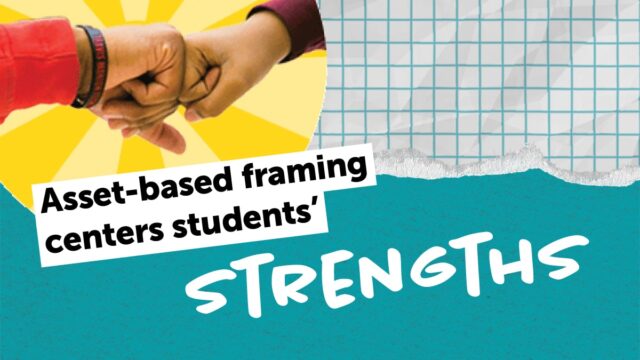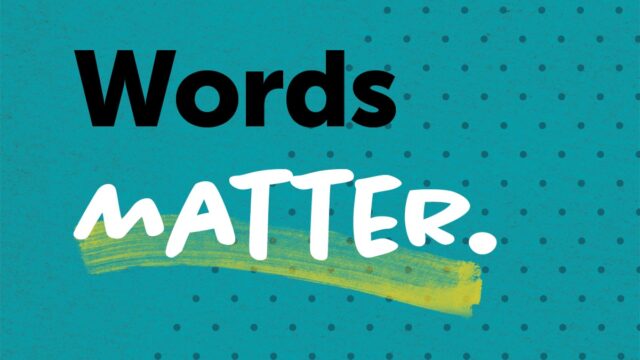Asset-based language mirrors the communities we serve
The importance of equitable and asset-based language
Not that long ago, City Year often used negative phrases and words to describe the students, schools and communities we serve. We didn’t do enough to check our own biases. Our framing and storytelling were often filtered through a lens using deficit language that was quick to identify problems, crises and failings but not as quick to recognize potential, strengths and opportunity.
We used phrases such as: at-risk youth; under-performing schools; and the high school graduation crisis.
You could argue these are just words and that actions matter much more. We agree that words without action can be empty. But we also believe that the words we use and the stories we tell and the way we frame our messaging all matter—a lot.
Communication tools can inform, compound or challenge our unconscious biases and prejudices. They can influence mindsets and beliefs and, yes, even actions. We know we have an obligation to choose our words carefully and think harder about the stories we tell, who tells them and how they are told.

Today, we don’t call the learners we serve “at-risk youth.” We strive to call out the talents, goals and accomplishments of young people instead, and focus on the resources, relationships and supports caring adults can provide students to help them flourish—highlighting solutions rather than simply “the problem.”
We try to describe the policies, practices and prejudices that have caused and contributed to structural injustices and inequities facing communities of color and people from lower-income neighborhoods. More often than not, we simply use the words “schools” and “students” in our storytelling and try to avoid negative descriptors.
We’ve a long way to go
Yet, our Marketing & Communications Department continues to use the phrase “systemically under-resourced” to describe the schools we serve when it seems important to make more clear why we serve in the places we do and how providing additional capacity to these schools helps to advance educational equity.
We struggle with the best way to describe lower-income students or communities when the context requires such details. Is ‘disadvantaged’ or ‘lower socio-economic status’ more or less asset-based? Are there better alternatives? How can we better mirror and honor the people we work with? These are some of the questions we are asking ourselves.
We still have a long way to go on our journey to become more asset-based in the language we use and the way we frame narratives. We’re eager to learn from others who are further along in adopting new mindsets and vocabulary to shape storytelling and messaging.

The damage of deficit language
What we’ve learned is that deficit framing often fails to acknowledge the root issues many communities face—such as racism, ableism, sexism, homophobia and other systemic oppression. Crisis storytelling can inadvertently stigmatize or place blame on individual people rather than shed light on systemic inequities that were created by people and groups in power—inequities that can be acknowledged and addressed.
Today, we more fully recognize that the words and framing we use can reinforce negative stereotypes and unconscious bias and their impact can last generations. We can unintentionally create or repeat damaging narratives that can harm communities.
The benefits of asset-based framing
We can offer our audiences new and, we hope, more equitable ways to think about the issues facing public education; the holistic supports all children need and deserve; and the inherent strengths and potential of our students, schools and communities.
We believe in the power of young people and our efforts to adopt an asset-based approach are not only reflected in the language we use to describe our work but also in how we carry out our work.
Our AmeriCorps members focus on building meaningful relationships with their students, supporting them as they hone their strengths and become adept learners. Through this experience, AmeriCorps members also learn and grow. By the time their service ends, City Year alumni are prepared to have a positive impact wherever they live and work.
We owe it to our corps, our students and the schools we serve to apply an asset-based lens to our storytelling that not only values the importance of diversity, inclusion, belonging and equity but also more accurately and fully captures the impactful, human-centered and, at times, joyful work they are all engaged in.
The challenge of pandemic storytelling
Since March 2020, how many times have you heard or read the terms “learning loss” or the “lost generation” as we grapple with the disruption, trauma and unfinished learning millions of students are experiencing? Or the well-intentioned but out-of-touch phrase “now more than ever….” which fails to acknowledge that the inequities exposed and exacerbated by the pandemic have long existed?
As we shared in our essay about why our organization is not using the term learning loss:
“We’re inspired by thought leaders who challenge the dominant “learning loss” narrative, and instead are urging us to view students as the multi-dimensional people they are and not reduce learning to a narrow, inaccurate and inequitable view of success…”
Inspiration from asset-based leaders
Over the past few years, City Year has become more aware of leaders such as Trabian Shorters, who shares his asset framing approach with nonprofits like ours and who has influenced our thinking.
We worked with Frameworks Institute to identify systemic factors that affect our students and schools and incorporate these factors into our messaging and storytelling.
We’ve been inspired by the asset-based work of other organizations, such as Center For Promise’s 2014 report Don’t Call Them Dropouts and by recent work of City Year’s own Research and Evaluation Team, which has embraced an equity-focused approach to their Research and Learning Agenda.
We’re grateful for the innovative, insightful and groundbreaking work of these leaders.
As Trabian Shorters points out, asset-based language is about not defining people by the challenges they face. By “[acknowledging] the aspiration before the challenge,” Shorters says, “you’re telling a truer story about me.” Our students and the communities we work alongside are not “obstacles to be moved” or problems to be solved. We want to tell a deeper, richer, truer story about them.
We know we can and must do better. Just as our messaging and framing today are different than it was 24 or 36 months ago, we believe the way we tell stories will, and should, continue to evolve.
Engage with our asset-based campaign
When we saw a set of infographics created by Subversive Thread’s Guide to Coded Language in Education with us a few months ago, we instantly connected with the project and saw its potential to highlight the importance of asset-based framing. It motivated us to reflect on our own journey and launch our own set of infographics that promote asset-based language.
We wanted to offer our community some of the alternatives we have gravitated toward in the past couple of years, knowing even they are imperfect and subject to change.
We’re also eager to learn from others about what has worked for them and their organizations and reflect on approaches that were not as helpful.
We hope you engage with our asset-based social media campaign on City Year’s Twitter and Instagram accounts.
Please comment and share! We’d love your ideas on how we can continue to learn, grow and better honor the students, schools and communities we serve.
Related stories
Because you'll be living on a stipend, it might be a good idea to hold off on that ottoman from...
Read more about Furnishing your apartment on a budget: Tips for AmeriCorps membersCity Year’s “Why We Matter” podcast explores the vital role of education and mentorship in empowering young people. Through interviews...
Read more about Why City Year’s student success coach network mattersRead more and check the City Year blog to learn the soft skills our corps members gain through a year...
Read more about Top five skills employers want you to have todayIf you speak with an alum of an historically Black college or university (HBCU) about their experience, you’ll quickly learn...
Read more about Serving with City Year sharpens job skills, HBCU graduate says















